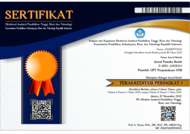Preservasi Digital Warisan Budaya: Sebuah Ulasan
Abstract
Digital preservation plays an important role in safeguarding cultural heritage. Along with the development of the times, cultural heritage as a valuableassetcannot be separated from potential threats in the form of damage and loss. Digital preservation is an aspect of opportunity in maintaining the sustainability of cultural heritage values. Through a qualitative approach with the literature study method, this research seeks to provide an overview of aspects of digital preservation in relation to efforts to protect cultural heritage. The results of the study illustrate that digital preservation has strong relevance in terms of protecting cultural heritage values from damage and loss. The involvement of technology in digital preservation results in convenience in efforts to save cultural heritage by representing cultural material in digital formats. Digital preservation has various challenges including technological obsolescence, loss or damage to data, intellectual property rights, preservation costs, metadata and contextual information, skills and expertise, social and ethical considerations, utilization, and various other things according to the context of implementation. A digital preservation strategy that includes aspects of technological environmental conservation for future use and handling of technical limitations is an integral part of overcoming existing challenges. By implementing various strategies and actively participating in the realm of digital preservation activities, the existence of cultural heritage with its noble values can be maintained and gain long-term accessibility for the sustainability of future generations.
Keywords
Full Text:
PDFReferences
Assembly, U. G., & 2nd C. (2016). Implementation of the outcomes of the United Nations Conferences on Human Settlements and on Housing and Sustainable Urban Development and strengthening of the United Nations Human Settlements Programme (UN-Habitat).
Bachiller, C., Monzo, J. M., & Rey, B. (2023). Augmented and virtual reality to enhance the didactical experience of technological heritage museums. Applied Sciences, 13(6), 3539.
Bowen, D. A. (2018). Challenges archivists encounter adopting cloud storage for digital preservation. Proceedings of the International Conference on Information and Knowledge Engineering (IKE), 27–33.
Brown, A. (2013). Practical digital preservation: A how-to guide for organizations of any size. Facet Publishing.
Cloonan, M. V. (2001). W(h)ither preservation? The Library Quarterly, 71(2), 231–242.
Corrado, E.M. & Moulaison, H. L. (2014). Digital preservation for libraries, archives, and museums. Rowman & Littlefield.
Garrett J, W. D. (1996). Preserving Digital Information, Report of the Task Force on Archiving of Digital Information. Research Libraries Group.
Hasugian, J. (2003). Penggunaan Bahasa Alamiah Dan Kosa Kata Terkontrol Dalam Sistem Temu Kembali Informasi Berbasis Teks. Jurnal Studi Perpustakaan Dan Informasi, 2(1982), 1–10.
Hidayah, Nurrohmah & Saufa, A. F. (2019). PRESERVASI DIGITAL ARSIP NASKAH KUNO : Studi Kasus Preservasi Arsip di Badan Arsip dan Perpustakaan Provinsi Jawa Tengah Abstrak kegiatan perawatan dan preservasi arsip . Hal ini diperlukan agar usia dari arsip dapat lembaga / perusahaan tertentu . Salah. Jurnal Ilmu Perpustakaan, 4(1), 41–51.
Irawati, I., Muljono, P., & Ardiansyah, F. (2023). KESIAPAN REPOSITORI INSTITUSI DI INDONESIA DALAM PRESERVASI DIGITAL Readiness of Institutional Repositories in Indonesia in Digital Preservation. Jurnal Perpustakaan Pertanian, 21(2), 3103554.
Lee, K. H., Slattery, O., Lu, R., Tang, X., & McCrary, V. (2002). The state of the art and practice in digital preservation. Journal of Research of the National Institute of Standards and Technology.
Limp, W. F. (1999). Geographic information systems in historic preservation. Archives and Museum Informatics, 13(3-4), 325–340. https://doi.org/10.1023/A:1012472528263
Lu, Dongming & Pan, Y. (2011). Digital preservation for heritages: Technologies and applications. Springer Science & Business Media.
Maryono, M., & Pramono, M. (2020). Pengembangan website koleksi langka Perpustakaan UGM sebagai preservasi digital heritage menuju era industri 4.0. Jurnal Kajian Informasi & Perpustakaan, 8(1), 1. https://doi.org/10.24198/jkip.v8i1.23348
Masenya, T. M., & Ngulube, P. (2014). Digital preservation practices in academic libraries in South Africa in the wake of the digital revolution. South African Journal of Information Management, 21(1), 1–9.
Mirawati, I. (2012). Melestarikan Cagar Budaya Jakarta Melalui Arsip.Majalah Arsip Media Kearsipan Nasional: Arsip dan Kearsitekturan, 57, Januari – April
Myntti, Jeremy & Zoom, J. (2019). Digital preservation in libraries: preparing for a sustainable future. In American Library Association. https://doi.org/10.1080/23257962.2019.1664435
Noonan, D. (2014). Digital preservation policy framework: A case study. EDUCAUSE Review online. http://www.educause.edu/ero/article/digital-preservation-policy-framework-case-study
Pendit, P. L. (2008). Perpustakaan Digital: Dari A sampai Z. Citra Karyakarsa Mandiri.
Pramartha, C., Davis, J., & Kuan, K. (2017). Digital preservation of cultural heritage: an ontology-based approach.
Putra, D. D., & Salim, T. A. (2019). Knowledge preservation of General Sudirman’s struggle in Pacitan: An opportunity to protect historical value to achieve Sustainable Development Goals. UI Proceedings on Social Science and Humanities, 3(1).
Raju, J. (2014). Knowledge and skills for the digital era academic library. Journal of Academic Librarianship, 40(2), 163–170. https://doi.org/10.1016/j.acalib.2014.02.007
Rothenberg, J. (1995). Ensuring the longevity of digital documents. Scientific American, 272(1), 42–47. https://doi.org/10.1038/scientificamerican0195-42
Rowat, T. (1993). The record and repository as a cultural form of expression. Archivaria.
Safira, F., Salim, T. A., Rahmi, R., & Sani, M. K. J. A. (2020). Peran Arsip Dalam Pelestarian Cagar Budaya Di Indonesia: Sistematika Review. Baca: Jurnal Dokumentasi Dan Informasi, 41(2), 289. https://doi.org/10.14203/j.baca.v41i2.593
UNESCO. (1972). Convention Concerning the Protection of the World Cultural and Natural Heritage. UNESCO.
UNESCO. (2023). What is Intangible Cultural Heritage? UNESCO.
Waugh, A., Wilkinson, R., Hills, B., & Dell’oro, J. (2000). Preserving digital information forever. Proceedings of the ACM International Conference on Digital Libraries, 175–184. https://doi.org/10.1145/336597.336659
Wei, W. (2019). Research progress on virtual reality (VR) and augmented reality (AR) in tourism and hospitality: A critical review of publications from 2000 to 2018. Journal of Hospitality and Tourism Technology, 10(4), 539–570. https://doi.org/10.1108/JHTT-04-2018-0030
Zed, M. (2008). Metode Penelitiaan Kepustakaan. Yayasan Obor.
DOI: https://doi.org/10.20961/jpi.v9i2.77398
Refbacks
- There are currently no refbacks.

This work is licensed under a Creative Commons Attribution-NonCommercial-ShareAlike 4.0 International License.




.png)
.png)









1.jpg)
